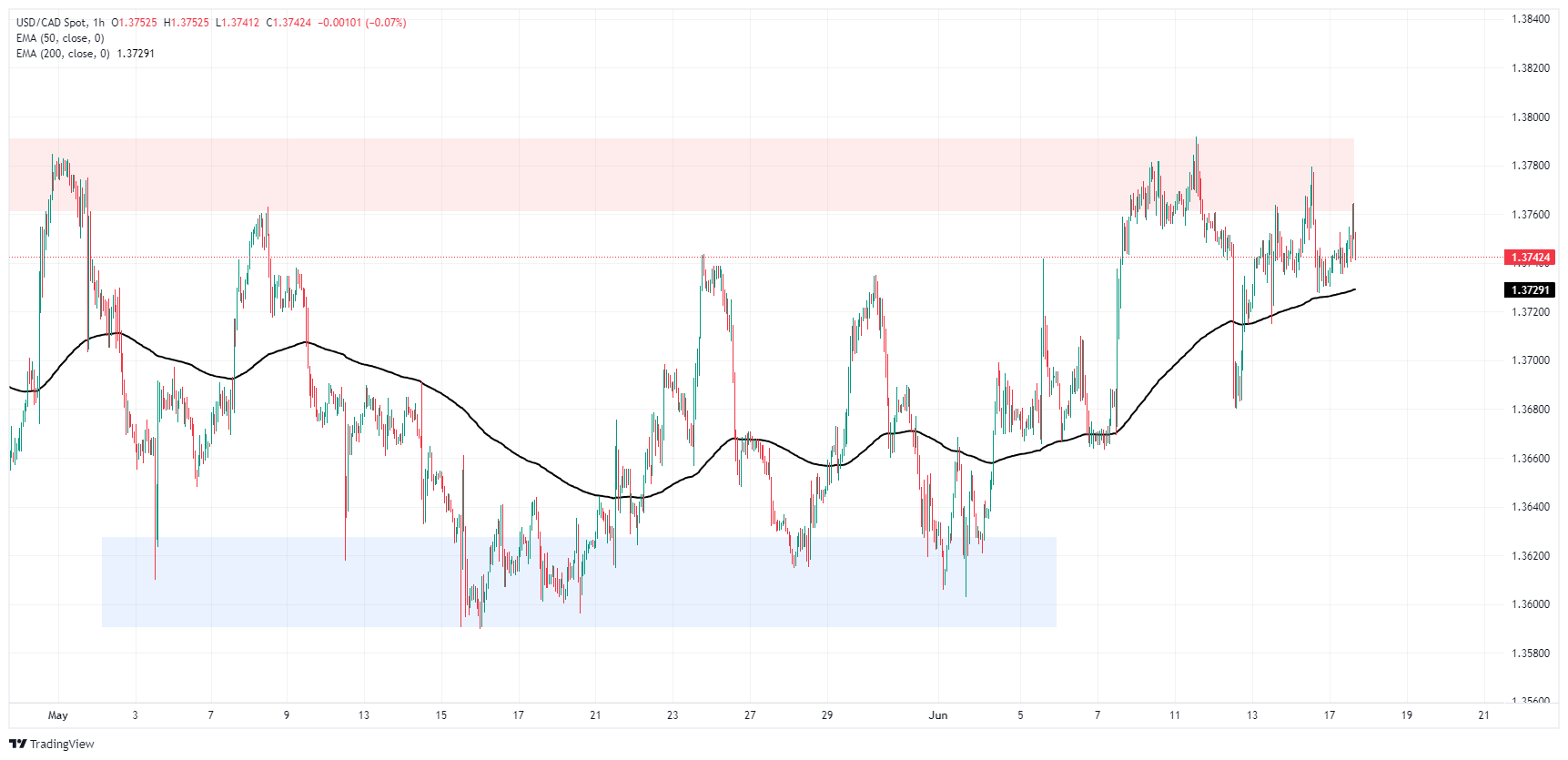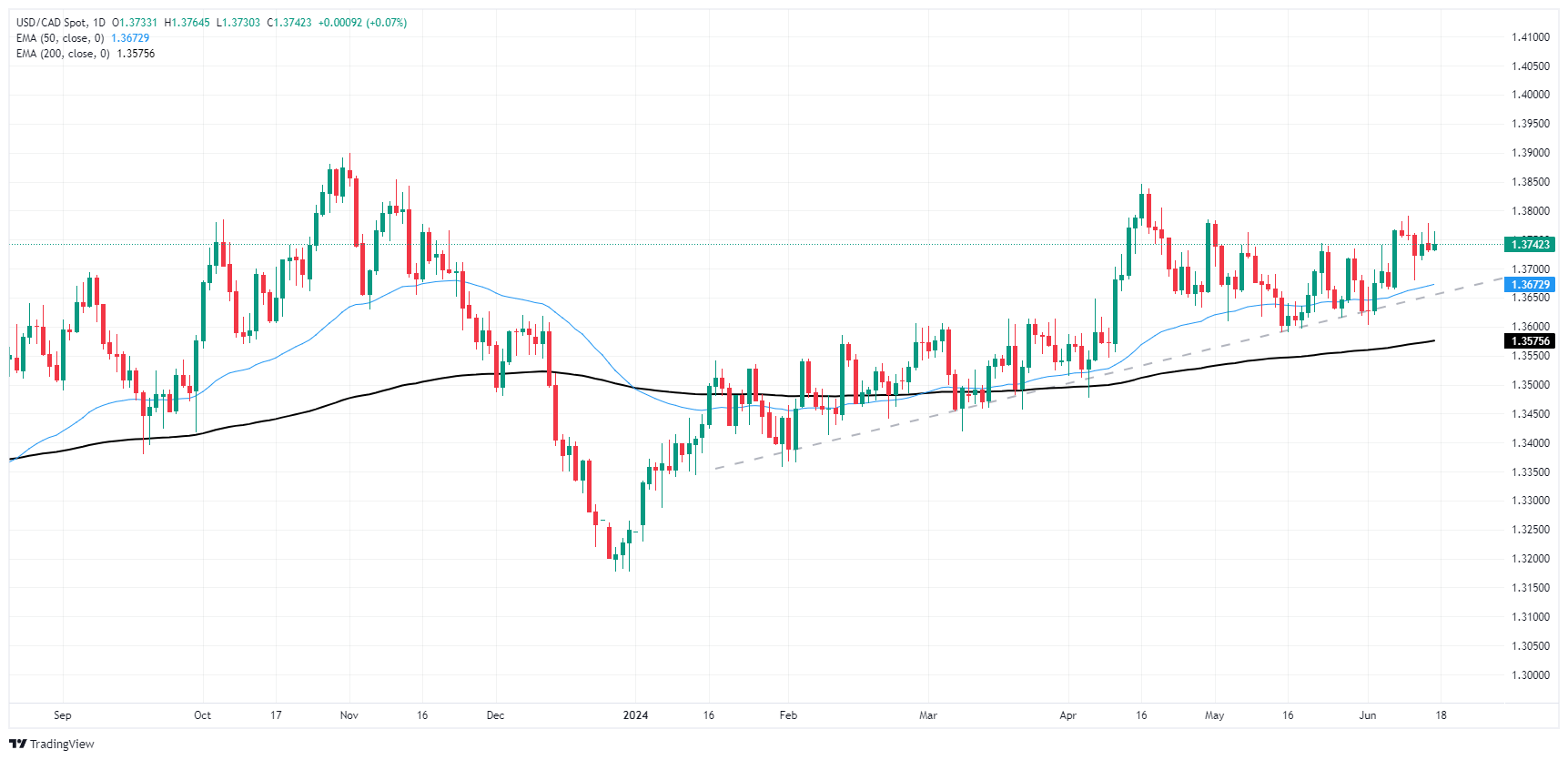Canadian Dollar flattens on Monday as markets await meaningful data

- Canadian Dollar treads lightly amidst quiet Monday markets.
- Canada Housing Starts rise faster than expected in May, but sales and prices are down.
- US NY Empire Manufacturing recovered, but Tuesday’s Retail Sales loom ahead.
The Canadian Dollar (CAD) is trading tightly on Monday, with gains and losses mixed across the board and within a quarter of a percent against most of its major currency peers. Canadian Housing Starts came in better than expected, but prices and activity remain lower in May. US manufacturing figures improved more than expected but still remain in contraction territory.
Canada saw Housing Starts rise more than expected for the year ending in May, but according to the Canadian Real Estate Association (CREA), both housing prices and buying activity declined in May. The US New York Empire Manufacturing Index rose faster than expected in June but still remains mired in contraction territory. Markets will shift into wait-and-see mode as investors look out for US Retail Sales figures due on Tuesday.
Daily digest market movers: Canadian Dollar finds tepid Monday markets and a limited data docket
- Canadian Housing Starts rose to 264.5K YoY in May, above the forecast for 247K and rising from the previous period’s revised 241.1K.
- However, the CREA’s Canadian Home Price Index fell 0.2% MoM in May and fell 2.4% YoY. The CREA also noted that home sales declined 0.6% MoM in May as activity remains constrained.
- The US NY Empire State Manufacturing Index recovered to a four-month high of -6.0 in June, higher than the forecast of -9.0 and well above the previous -15.6. Despite the recovery, the NY Empire index has remained in contraction territory since November of last year.
- Tuesday’s US Retail Sales will be the key data release of the early week, and investors will be keeping one eye turned to the news feeds. A slew of policymakers from the Federal Reserve are expected to appear this week.
- Wednesday’s Juneteenth US holiday will see a lull in the midweek market flow.
Canadian Dollar PRICE Today
The table below shows the percentage change of Canadian Dollar (CAD) against listed major currencies today. Canadian Dollar was the strongest against the Japanese Yen.
| USD | EUR | GBP | JPY | CAD | AUD | NZD | CHF | |
|---|---|---|---|---|---|---|---|---|
| USD | -0.30% | -0.17% | 0.19% | -0.15% | -0.01% | -0.01% | -0.08% | |
| EUR | 0.30% | 0.15% | 0.51% | 0.16% | 0.20% | 0.34% | 0.22% | |
| GBP | 0.17% | -0.15% | 0.44% | -0.01% | 0.04% | 0.15% | 0.09% | |
| JPY | -0.19% | -0.51% | -0.44% | -0.24% | -0.21% | -0.07% | -0.22% | |
| CAD | 0.15% | -0.16% | 0.00% | 0.24% | 0.08% | 0.13% | 0.08% | |
| AUD | 0.01% | -0.20% | -0.04% | 0.21% | -0.08% | 0.19% | 0.06% | |
| NZD | 0.01% | -0.34% | -0.15% | 0.07% | -0.13% | -0.19% | -0.06% | |
| CHF | 0.08% | -0.22% | -0.09% | 0.22% | -0.08% | -0.06% | 0.06% |
The heat map shows percentage changes of major currencies against each other. The base currency is picked from the left column, while the quote currency is picked from the top row. For example, if you pick the Canadian Dollar from the left column and move along the horizontal line to the US Dollar, the percentage change displayed in the box will represent CAD (base)/USD (quote).
Technical analysis: Canadian Dollar churns in the midrange on Monday
The Canadian Dollar (CAD) is comfortably splashing around in the shallow end on Monday, trading within a quarter of one percent across the board as markets kick off the new trading week on a notably tepid note. USD/CAD briefly found an intraday high above 1.3760 before pulling back into a familiar midrange near 1.3740.
Intraday price action remains mired on the low side of a heavy supply zone above 1.3760, but long-term momentum still leans into the bullish side as the pair holds north of the 50-day Exponential Moving Average (EMA) at 1.3673. USD/CAD has been grinding higher on a rising trendline, climbing from December’s swing low below 1.3200, but the pair has failed to etch in a fresh high since peaking at 1.3846 in mid-April.
USD/CAD hourly chart
USD/CAD daily chart
Canadian Dollar FAQs
The key factors driving the Canadian Dollar (CAD) are the level of interest rates set by the Bank of Canada (BoC), the price of Oil, Canada’s largest export, the health of its economy, inflation and the Trade Balance, which is the difference between the value of Canada’s exports versus its imports. Other factors include market sentiment – whether investors are taking on more risky assets (risk-on) or seeking safe-havens (risk-off) – with risk-on being CAD-positive. As its largest trading partner, the health of the US economy is also a key factor influencing the Canadian Dollar.
The Bank of Canada (BoC) has a significant influence on the Canadian Dollar by setting the level of interest rates that banks can lend to one another. This influences the level of interest rates for everyone. The main goal of the BoC is to maintain inflation at 1-3% by adjusting interest rates up or down. Relatively higher interest rates tend to be positive for the CAD. The Bank of Canada can also use quantitative easing and tightening to influence credit conditions, with the former CAD-negative and the latter CAD-positive.
The price of Oil is a key factor impacting the value of the Canadian Dollar. Petroleum is Canada’s biggest export, so Oil price tends to have an immediate impact on the CAD value. Generally, if Oil price rises CAD also goes up, as aggregate demand for the currency increases. The opposite is the case if the price of Oil falls. Higher Oil prices also tend to result in a greater likelihood of a positive Trade Balance, which is also supportive of the CAD.
While inflation had always traditionally been thought of as a negative factor for a currency since it lowers the value of money, the opposite has actually been the case in modern times with the relaxation of cross-border capital controls. Higher inflation tends to lead central banks to put up interest rates which attracts more capital inflows from global investors seeking a lucrative place to keep their money. This increases demand for the local currency, which in Canada’s case is the Canadian Dollar.
Macroeconomic data releases gauge the health of the economy and can have an impact on the Canadian Dollar. Indicators such as GDP, Manufacturing and Services PMIs, employment, and consumer sentiment surveys can all influence the direction of the CAD. A strong economy is good for the Canadian Dollar. Not only does it attract more foreign investment but it may encourage the Bank of Canada to put up interest rates, leading to a stronger currency. If economic data is weak, however, the CAD is likely to fall.
